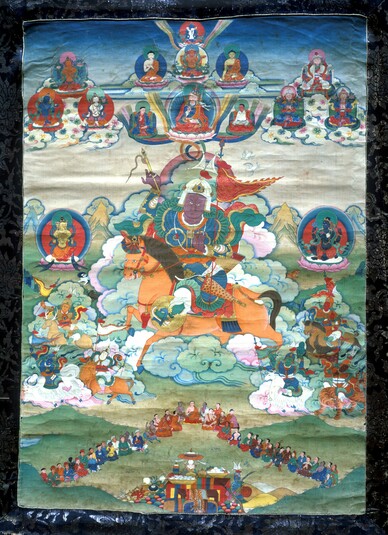
Item: Worldly Protector (Buddhist)
| Origin Location | Eastern Tibet |
|---|---|
| Date Range | 1900 - 1959 |
| Lineages | Nyingma |
| Material | Ground Mineral Pigment on Cotton |
| Collection | Private |
Classification: Deity
Drala, worldly protector. The central figure riding a horse, currently unidentified, in Drala appearance, has some similarities to King Gesar but the retinue does not correspond well with the writings on Gesar popularized by Mipam Rinpoche in the 19th century. It is possible that this form of Gesar is based on a 'Revealed Treasure' or 'Pure Vision' of some other teacher from Kham in the 19th century.
The central figure is in the appearance of a Tibetan Drala warrior. He is maroon in colour with one face and two hands holding upraised in the right a riding whip and in the left a spear with a red banner. He rides atop a light brown horse surrounded by blue, green and pink billowing clouds. Two white birds follow in the sky above.
Drala is flanked on the viewer's left by a kneeling yellow Brahma and on the right by a kneeling blue Vishnu - both with prominent circles of radiant light. Below Drala on the left are three warriors riding various mounts - possibly a beige coloured deer, light brown 'kyang' and white yak. On the right are three warriors also riding various mounts - a brown goat, white sheep and a tiger.
At the top center is blue Samantabhadra with consort. Below that is orange Prajnaparamita with four arms accompanied by the previous Buddha Dipamkara and the current Buddha Shakyamuni. Below that is Padmasambhava with two male figures wearing layman attire.
At the top left are the Three Bodhisattva Lords, orange Manjushri, blue Vajrapani and white Avalokiteshvara. On the right side are the Three Tibetan Kings, Songtsen Gampo, Trisong Detsen and Ralpachen.
In the lower third of the composition is a central yogi-like figure accompanied by other yogi and monastic figures and an assortment of lay individuals with the males predominantly on the left side and females on the right. At the bottom center is a large gathering of offerings and precious objects such as wish-fulfilling jewels, the eight auspicious emblems, gold, red coral, bolts of cloth, offering bowls filled with substances of various types along with 19th century Tibetan rifles.
A Chinese language publication (2003) on the life and narrative of King Gesar identifies this painting as Gesar. No visual comparables, inscriptions, or Tibetan text references are offered in support of this identification. (See the text at ISBN 7-80024-698-1)
Jeff Watt 4-2011
Front of Painting
English Translation of Inscription: [There does not appear to be any inscriptions on the front]
Reverse of Painting
English Translation of Inscription: [It is currently unknown if there are any inscriptions or drawings on the reverse of the painting]
Collection: Private 4 (Painting 20th Century)
Collection: Private 4, Painting (Masterwork Galleries)
Collection: Private 4 (Painting)
Painting: Figurative Art Main Page
Deity, Tibetan: Warrior Iconography list
King: Gesar Religious Context
King: Gesar Main Page
Deity, Tibetan: Warrior Appearance (Drala)
Subject: Composition - Floating Figure
Collection: Private 4 (Protectors)
Collection: Private 4 (Painting 19th Century)
Collection: Private 4 (Historical & Interesting)
